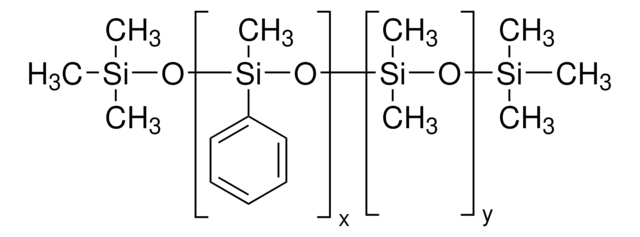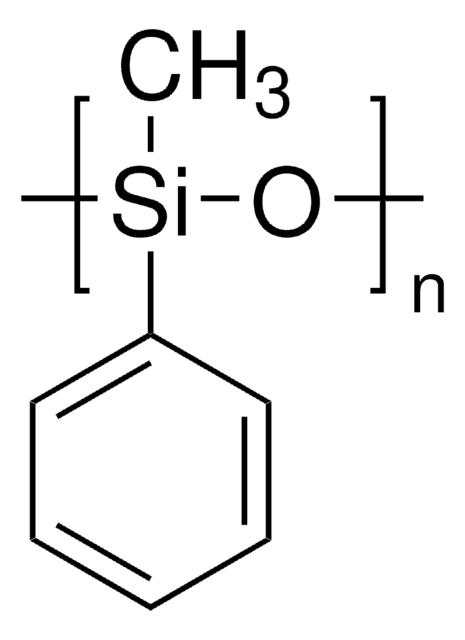10836
Silicone oil AR 20
viscosity ~20 mPa.s, neat(25 °C)
Synonyme(s) :
Polyphenyl-methylsiloxane
Se connecterpour consulter vos tarifs contractuels et ceux de votre entreprise/organisme
About This Item
Produits recommandés
Indice de réfraction
n20/D 1.441-1.445
Niveau de qualité
Viscosité
~20 mPa.s, neat(25 °C)
Densité
1.000-1.020 g/mL at 20 °C
Description générale
Silicone oil AR 20 is a polydimethylsiloxane with phenyl groups that is commonly used as a heat transfer or pressure transfer fluid.
Application
Silicone oil AR 20 has been used:
- As a Segmenting fluid in polymerase chain reaction (PCR).
- In hollow fiber liquid-phase microextraction (LPME) procedure for extraction of hydrophobic drugs from human breast milk.
- As a fluid to demonstrate pores in droplet interface bilayers (DIBs).
Caractéristiques et avantages
Especially good thermostability (-50°C to +230°C)
Code de la classe de stockage
10 - Combustible liquids
Classe de danger pour l'eau (WGK)
WGK 3
Point d'éclair (°F)
338.0 °F - Not applicable
Point d'éclair (°C)
170 °C - Not applicable
Équipement de protection individuelle
Eyeshields, Gloves
Faites votre choix parmi les versions les plus récentes :
Déjà en possession de ce produit ?
Retrouvez la documentation relative aux produits que vous avez récemment achetés dans la Bibliothèque de documents.
Les clients ont également consulté
Liquid-phase microextraction of drugs from human breast milk
Bj?rhovde, A, et al.
Analytica Chimica Acta, 491(2), 155-161 (2003)
Formation of droplet interface bilayers in a Teflon tube
Walsh E, et al.
Scientific reports, 6(2), 34355-34355 (2016)
E J Walsh et al.
Biomedical microdevices, 7(4), 269-272 (2006-01-13)
This paper evaluates the compatibility of segmenting fluids for two phase flow applications in biomedical microdevices. The evaluated fluids are chosen due to the variations in fluid properties and cost, while also reflecting their use in the recent literature. These
Helena L E Coker et al.
Biophysical journal, 116(6), 1085-1094 (2019-03-09)
Diffusion in cell membranes is not just simple two-dimensional Brownian motion but typically depends on the timescale of the observation. The physical origins of this anomalous subdiffusion are unresolved, and model systems capable of quantitative and reproducible control of membrane
Gema Flores et al.
Journal of chromatography. A, 1153(1-2), 29-35 (2007-02-20)
A method based on the use of absorbents as packing materials in the interface of the direct coupling between reversed phase liquid chromatography and gas chromatography (RPLC-GC) is proposed. To that end, a comparative study on different adsorbents and absorbents
Notre équipe de scientifiques dispose d'une expérience dans tous les secteurs de la recherche, notamment en sciences de la vie, science des matériaux, synthèse chimique, chromatographie, analyse et dans de nombreux autres domaines..
Contacter notre Service technique




